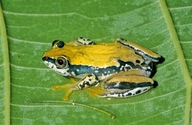|
Description
A medium-sized, uniformly colored species of Heterixalus . Males are 23-26 mm in total length, while one female was 28 mm in snout vent length. The back is uniformly colored and looks white in bright sunlight. Females have two black markings above the eyes and two rows of black spots running laterally. These patterns are less distinct in males. Thighs, ventral surface of limbs, hands and feet are orange. Venter is creamish in color.
The typical call can be described as "eeep-ep". Two unharmonious note types are present: first type lasts 80-90 ms; second type is shorter, lasting 40-60 ms. Intervals after note type 1 are about 100 ms and notes are arranged in groups, most usually as "1-2" Other combinations are "1-2-2", rarely "1-2-2-2". Frequency ranges from 2.2 to 3.8 kHz.
Similar species : Heterixalus madagascariensis lacks the black spots above the eyes and has a different call. H. "variabilis" displays great variability in coloration, but the typical color patterns of H. tricolor females were not found.
Distribution and Habitat
Country distribution from AmphibiaWeb's database: Madagascar
Ampijoroa, Ankarafantsika (Antsiloky), Kirindy, Nosy Be (TL), Nosy Komba. It occurs from sea level to 300m asl in open areas, rice fields, agricultural areas, and dry forest (Nussbaum et al. 2008).
Life History, Abundance, Activity, and Special Behaviors
Habitats: Swamps and ricefields of north-western and western Madagascar.
Calls: A long note followed by one or several short notes.
Calling males were observed during the night in rice fields, together with Ptychadena mascareniensis and Boophis tephraeomystax During the day, these frogs hide in the axils of broad-leaved plants.
Breeding takes place in permanent and temporary still waters (Nussbaum et al. 2008).
Trends and Threats
It occurs in Parc National d'Ankarafantsika (Nussbaum et al. 2008). Comments
Taken with permission from Glaw and Vences (2007).
References
Glaw, F., and Vences, M. (2007). Field Guide to the Amphibians and Reptiles of Madagascar. Third Edition. Vences and Glaw Verlag, Köln.
Nussbaum, R., Vences, M., and Glaw, F. (2008). Heterixalus tricolor. In: IUCN 2008. 2008 IUCN Red List of Threatened Species. www.iucnredlist.org. Downloaded on 21 April 2009.
Originally submitted by: Miguel Vences and Frank Glaw (first posted 2002-02-04)
Edited by: Henry Zhu (2010-07-18)Species Account Citation: AmphibiaWeb 2010 Heterixalus tricolor <https://amphibiaweb.org/species/494> University of California, Berkeley, CA, USA. Accessed Jun 7, 2025.
Feedback or comments about this page.
Citation: AmphibiaWeb. 2025. <https://amphibiaweb.org> University of California, Berkeley, CA, USA. Accessed 7 Jun 2025.
AmphibiaWeb's policy on data use.
| 